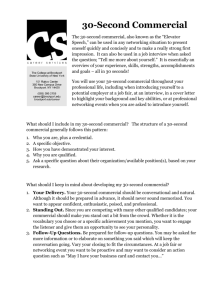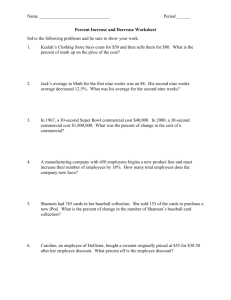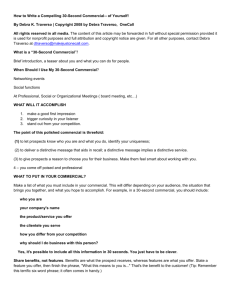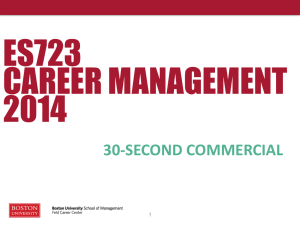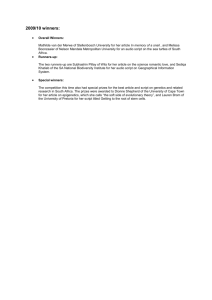How to Write a Script for a 30-Second Radio Spot
advertisement
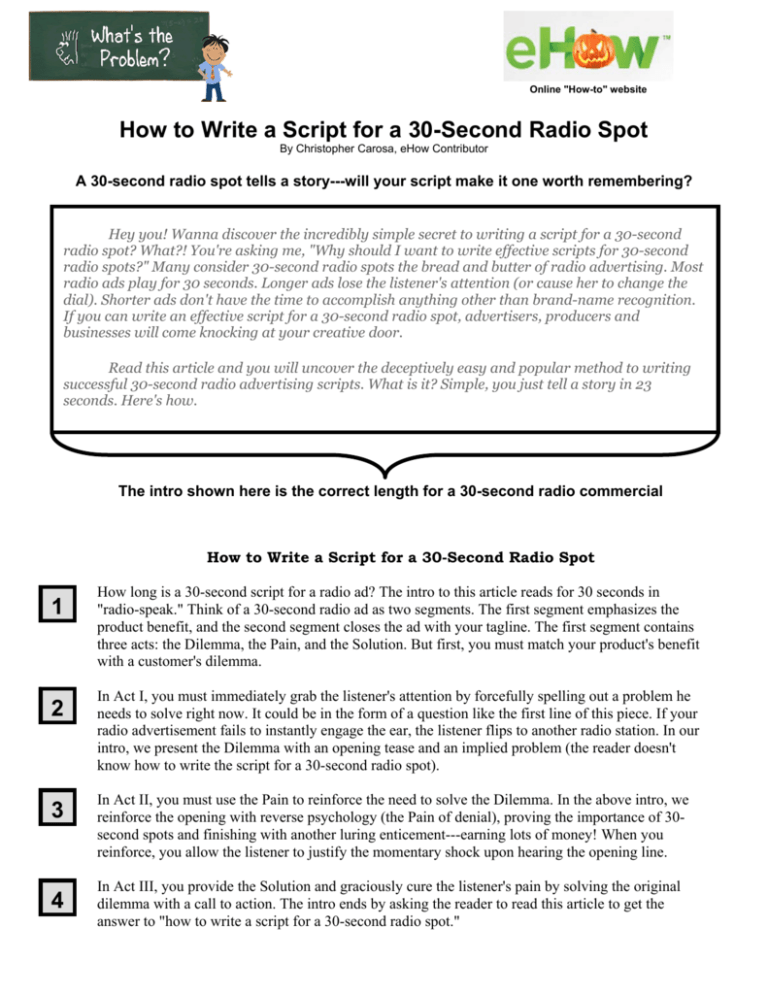
Online "How-to" website How to Write a Script for a 30-Second Radio Spot By Christopher Carosa, eHow Contributor A 30-second radio spot tells a story---will your script make it one worth remembering? Hey you! Wanna discover the incredibly simple secret to writing a script for a 30-second radio spot? What?! You're asking me, "Why should I want to write effective scripts for 30-second radio spots?" Many consider 30-second radio spots the bread and butter of radio advertising. Most radio ads play for 30 seconds. Longer ads lose the listener's attention (or cause her to change the dial). Shorter ads don't have the time to accomplish anything other than brand-name recognition. If you can write an effective script for a 30-second radio spot, advertisers, producers and businesses will come knocking at your creative door. Read this article and you will uncover the deceptively easy and popular method to writing successful 30-second radio advertising scripts. What is it? Simple, you just tell a story in 23 seconds. Here's how. The intro shown here is the correct length for a 30-second radio commercial How to Write a Script for a 30-Second Radio Spot 1 2 3 4 How long is a 30-second script for a radio ad? The intro to this article reads for 30 seconds in "radio-speak." Think of a 30-second radio ad as two segments. The first segment emphasizes the product benefit, and the second segment closes the ad with your tagline. The first segment contains three acts: the Dilemma, the Pain, and the Solution. But first, you must match your product's benefit with a customer's dilemma. In Act I, you must immediately grab the listener's attention by forcefully spelling out a problem he needs to solve right now. It could be in the form of a question like the first line of this piece. If your radio advertisement fails to instantly engage the ear, the listener flips to another radio station. In our intro, we present the Dilemma with an opening tease and an implied problem (the reader doesn't know how to write the script for a 30-second radio spot). In Act II, you must use the Pain to reinforce the need to solve the Dilemma. In the above intro, we reinforce the opening with reverse psychology (the Pain of denial), proving the importance of 30second spots and finishing with another luring enticement---earning lots of money! When you reinforce, you allow the listener to justify the momentary shock upon hearing the opening line. In Act III, you provide the Solution and graciously cure the listener's pain by solving the original dilemma with a call to action. The intro ends by asking the reader to read this article to get the answer to "how to write a script for a 30-second radio spot." 5 Once you've completed your three-act story of the first segment, attach your 7-second tagline and viola! -- you just finished your script for a 30-second radio spot. There's no tagline in the intro, but there are other sources for finding how to write a script for a radio tagline. 6 Repeat as needed for the number of 30-second spots in your radio marketing campaign's rotation. Be sure to emphasize different benefits in the rotation if you're featuring the same product. If you're promoting different products, show how the same benefits can be obtained in different ways. Tips & Warnings A 30-second spot often features two characters talking to each other. In this case, it is scripted much like a stage play. Write clearly and unambiguously. Reading your script aloud often lets you catch potential gaffes. Remember, your primary purpose in writing the script is listener understanding. In a radio script, indicate sound effects with the phrase "SFX" in place of the speaker's name. If your script sounds too close to the station format, listeners might mistake your ad for part of the radio show. You should avoid the use of audio homonyms. These go beyond the ones your English teacher taught you and include potentially confusing phrases like "go for" which, when read quickly, might sound like "gopher." Unless you're giving a telephone number or an address, you should try to stay away from using numbers with more than two syllables. Long Web addresses or confusing Web addresses make it harder for the listener to understand. If you have a Web address that contains a number, how will you let the listener know if the number is written in numeral form or spelled out? Likewise, you can spell "and" in your Web address either "and" or "&." Source: http://www.ehow.com/how_4895916_write-script-second-radio-spot.html
